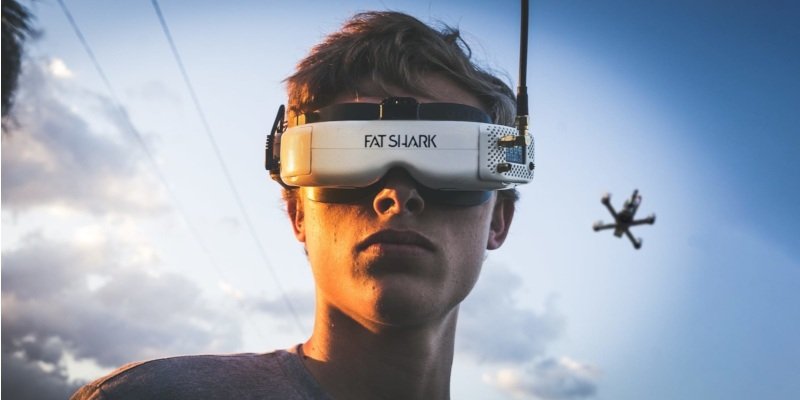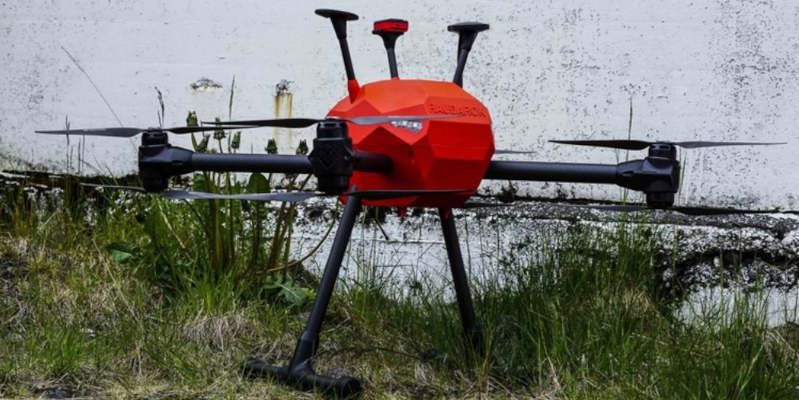Today, drones are used across the US for film production, search and rescue, defense, and 8% of Americans own them just for fun. Fortune Business Insights predicts the drone market will grow to $8.53bn by 2027, a more than 5x growth from the $1.59bn 2019 market size figure.

Drones are commonly made from metals, carbon fiber, or plastics. However, 3D printed drones are becoming more popular, more so in the past few years – and we’ll run through some of the best 3D printed drone projects today in this article.
1. 3D Printed Drones for Racing & Freestyle
Freestyle and racing drones are a rapidly growing drone niche. They require high-performance drones that are incredibly powerful, fast, and light, lending themselves well to improvement by utilizing additive manufacturing. If racing and freestyle drones interest you, you can check out the STL files for this free micro version to get started.

Freestyle drone pilots will also typically use FPV goggles linked to cameras on their drones, affording them better control and the sensation of direct flight. In fact, many freestyle and racing drones are improved with a recorded first person view, and are generally designed with a mounted camera in mind.

3D printed drones designed for racing don’t get much cooler than the Firefly Pro, which you can learn all about on Instructables.
However, they’re frequently crashed and need repairs, especially when used for outdoor flying, which can be a major problem. Fortunately, 3D printing spare parts is an excellent, cost-effective way to maintain and even upgrade your drone.
3D Printed Drone Parts
Drone propellers are relatively cheap to replace. Drone frames, however, can easily cost between $60 to $140.
Although most crashes won’t require the entire frame to be replaced (sometimes duct tape will do), regularly buying replacement parts can easily add up to this, though we can’t promise that repairing or replacing your FPV camera will be quite as easy.

However, pilots who own 3D printers can simply print their own replacement parts. It’s lucky then that out of all the components that go into drones, props and frames also happen to be the most widely and easily 3D printed.
3D printing drone parts like this leg or these extensions is incredibly cheap. The material cost of reprinting an entire new frame rarely exceeds $5, making even the most extensive repairs far cheaper than buying replacements provided you can find good and reliable STL files.

If you’ve got 3D printed drones, we recommend saving the files you used for quick and easy replacement parts.
2. Clogworks Dark Matter Drones
Clogworks is a drone R&D and manufacturing company founded in Yorkshire, England, known for their “Dark Matter” 3D printed drones. They specialize in producing drones for industrial, commercial, and security operations, rather than for private consumption.
Rather than using conventional methods to produce prototypes and models, Clogworks 3D print drones instead. Whilst discussing their process, Peter Opdam, the company’s co-founder, stated that:

“3D printing allows us to create a part [and] test it, without being restricted to having to create large volumes of parts… It’s a big improvement, it means that we can produce our own parts, test and look at them. We don’t have to involve a third party to produce a product that usually ends up not being exactly like the way I wanted.”
3D printing is an established part of many R&D processes, with the drones of many NATO militaries being designed and developed using 3D printing. What cases such as Clogworks show us, is just how close 3D printing is to becoming the standard process.
3. The Svarmi Rauðarok
Whereas Clogworks uses 3D printing for their drone production, Svarmi uses 3D printing to optimize the service potential of their drones. The Icelandic company provides remote aerial sensing and data collection for clients such as architects and researchers with partially 3D printed drones, combining 3D printing with traditional manufacturing methods.
To provide this service, Svarmi’s drones often have to be customized to meet the needs of their clients. During an interview, they stated that:
“Our product development is based on our customer’s requirements. We design our drones according to their wishes or integrate the sensors they require for very specific remote sensing missions.”
Svarmi uses fixed-wing and multirotor drones equipped with custom sensors to complete their missions. Their previous model of multirotor drone used CNC-cut carbon fiber. Seeking to upgrade, began 3D printing their multirotor, resulting in their Rauðarok drones.
The Rauðarok features a completely 3D printed frame, with metal legs and supports. The new design is lighter, has less components, and can be produced and modified much faster than its carbon fiber predecessor.

“The resulting drone was a great success, to say the least. The number of components was reduced by a factor of almost 6. And the time to assemble the drone went from being almost two weeks to two days including all the soldering required.”
As a service-based company this faster production speed and cheaper cost meant that they could take on more clients and make more profits. This profit boost dramatically shifted Svarmi’s fortunes, with the company later admitting that 3D printing essentially saved their business.

“We often need to design complex three-dimensional parts that before would just have been way too expensive to manufacture… Without 3D printing, Svarmi would not have been able to survive, it’s as simple as that.”
4. The Lifesaving X Vein
The X Vein is a 3D printed drone from a student project by prodigious pupils Yuki Ogasawara and Ryo Kumeda. Together they won the National Student Flying Robot Contest with their new drone design.
The great earthquake in Japan in 2011 claimed over 18,000 lives, it was one of the greatest natural disasters in recent history, and one the world will not soon forget.
The X Vein drone came from their original design, along with the hard work of Team ROK, who built on the original design to assemble a final product, complete with installed infrared and thermographic imaging to spot anyone who may need help after such a disaster, even if they’re trapped in buildings or under rubble.
3D printing the X Vein not only allowed the team to adapt easily as designs were changed and updated through rapid prototyping, but also made the wire frame lighter and more versatile.
To maximize efficiency and save more lives, the X Vein needed to be fast, easy to fly, and able to stay airborne for as long as possible. The additive manufacturing parts in the drone were far lighter than traditionally manufactured parts, helping it stay out for long enough to help people.
5. Skeleton X-14 Quadcopter
3D printed drones don’t all have to be big commercial projects or public service tools, sometimes they can just be awesome projects you can make yourself.
The Skeleton X-14 Quadcopter is a 3D printed drone designed for creators to customize, tinker with, redesign, and even update to their liking. You can change the design, rework the inner components, or even secure better hardware to make the motors faster or create more user-friendly flight controllers.

The mesh frame design makes this drone lightweight by design, and also makes the inner workings and electronic components visible for anyone interested in observing or teaching the mechanics of flying drones. So if you’re interested in customizing, printing, and flying your own drone, then you can download the Skeleton X-14 Quadcopter files for free on 3DCults.
Drones don’t only have the potential to help in natural disasters, they can also help with smaller emergencies too, like lifeguarding.
6. General Drones Auxdron LFG
General Drones has teamed up with the Valencia council in their Stop Drowning project, aimed at raising awareness of water safety as well as improving response times and increasing rescue mission success rates.
The Auxdron LFG is a sturdily built drone capable of handling harsh environments even when flying at its maximum speed of 60km/h, which it can reach in as little as 6 seconds. It’s also equipped with safety features, allowing for self-diagnosis and automatic engine shutdown in case of failure.
Exhibited all over Spain in Valencia, Benidorm, Miramar, and many more, the Auxdron LFG is the future of water safety and emergency rescue.
As you can see in the video above, the Auxdron LFG 3D printed drones are capable of delivering a lifejacket to a drowning person to buy time while the team prepares the actual rescue. This may seem like a small job, but it could be the difference between life and death in an emergency situation such as this.
7. Piccolissimo Drone
The Piccolissimo, designed by University of Pennsylvania robotics students, is quite possibly the world’s smallest drone. Where larger drones rely on the four-motor design to keep them balanced while in the air, as seen with the X-14 above, the Piccolissimo uses what’s called passive stability to keep itself aloft and stable with just one motor.
The Piccolissimo drone essentially uses a built-in ballast system to ensure correct calculation of gravity so it doesn’t need to rely on a larger frame or extra propellers to stay aloft. With a very high power-to-weight ratio, the Piccolissimo doesn’t rely on four motors or extra electronic components to be useful and fly in the correct direction.
Because The Piccolissimo needed to be as light as possible to enable easy flight, 3D printing was instrumental to this tiny drone’s construction, using minimal materials and applying their experience with engineering and robots to streamline manufacturing and creating something that hits that sweet spot between both efficient cost-effectiveness and power.

While a tiny drone may sound like a gimmick, the potential applications of such a small, light drone are many. This small drone can carry around 1g, which is enough for a small panoramic camera or even an infrared sensor, giving it great potential as a game changer for security purposes like CCTV or airport security. It can even be used as a solution for recording live events like plays and music gigs without being distracting to the audience.
If you’d like to learn more about the Piccolissimo drone, you can find all the information you’ll need here.
8. AldoraTech Commercial Drones
Drone delivery has been a noteworthy topic in recent years, though how many have we actually seen around? AldoraTech aims to change various industries all over the world.
Using 3D printing technology, AldoraTech’s unmanned drones are versatile and lightweight but still able to carry relatively heavy payloads, making them ideal for fast and reliable drone delivery.

AldoraTech’s idea for the future is to enhance people’s lives while also helping cut carbon emissions. By using battery-powered drones made with 3D printing, they hope to create and maintain efficient, sustainable homes and communities while still marching ceaselessly into the future.
If any of this sounds interesting to you, you can see everything AldoraTech does and even apply to collaborate with them on their official website.
9. CargoCopter
The CargoCopter is another delivery drone built by university students in Belgium. Using 3D printing for rapid prototyping, they were able to completely print a working delivery drone capable of carrying up to 5kg at a speed of 150km/h over a maximum distance of 60km.
The design is both wing- and propellor-based, unlike most 3D printed drones, making it a versatile drone that can maintain stability in flight to keep the payload from shaking while in transit.
This impressive drone is perfect for commercial use for both planned and last-minute deliveries. The precise takeoff and landing calculations mean the CargoCopter can deliver right to any door in no time at all, keeping the package secure and safe both in flight and while making the delivery itself on the ground.














